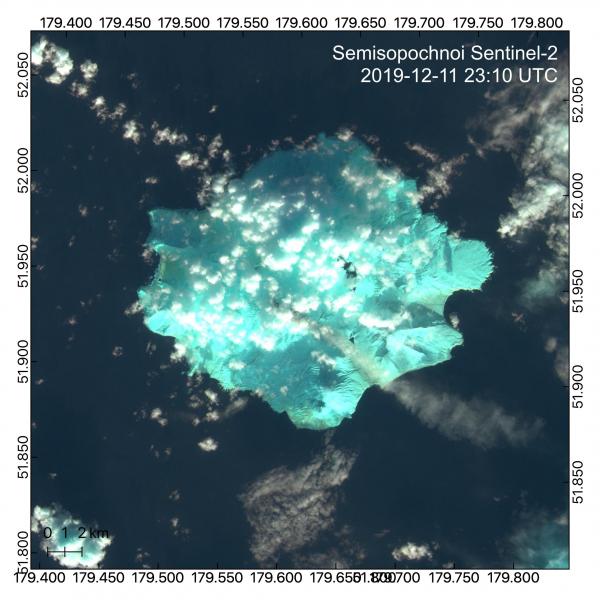
A gray plume bearing some ash is visible extending up to 17 km (10.5 miles) from the north crater of Cerberus in this Sentinel-2 natural color image. The area around the crater is snow free, but no deposits are visible on the snow.
Volcano(es): Semisopochnoi
Photographer: Dietterich, Hannah
URL: avo.alaska.edu/image/view/156561
Credit: Sentinel-2 Copernicus
Use Restriction: None.
Full Resolution.
Semisopochnoi 2019/7
From Orr and others, 2023: "Activity at the north cone of Mount Young, which began in September 2018, continued in 2019 with sporadic eruptive activity. Seismic tremor and explosion signals captured most of this activity, along with infrequent infrasound detections and occasional satellite observations of steam and small ash deposits. Although the eruptive style and geophysical characteristics of the 2019 unrest were similar to those of 2018, AVO’s ability to observe them in real time was limited for the first half of the year owing to a prolonged data outage. This outage, caused by a communication failure at the regional data network telemetry hub in Amchitka, lasted from November 2018 to June 2019, at which point communications were restored and the missing data were recovered.
"Owing to the data outage, the first activity observed at the volcano in 2019 comprised satellite observations of steam in January and a small ash deposit on June 2. Although the north crater of Mount Young has persistently steamed since 2018, the ash deposits observed on June 2 appear to be a more recent change, having followed tremor bursts in mid-May that probably correspond to when they erupted. AVO began receiving seismic data again on June 11 but kept the Aviation Color Code and Volcano Alert Level at UNASSIGNED until early July, when increased tremor prompted a change to YELLOW and ADVISORY. On July 18, the detection of SO2 emissions in TROPOMI satellite data and the recording of ground-coupled airwaves triggered AVO to raise the Aviation Color Code and Volcano Alert Level to ORANGE and WATCH. SO2, steam plumes, ground-coupled airwaves, and infrasound were detected throughout the summer, but no ash deposits were observed. After a period of quiescence, AVO lowered the Aviation Color Code and Volcano Alert Level to YELLOW and ADVISORY on September 18.
"Beginning on December 7, the detection of many explosions by regional infrasound sensors indicated a renewal of activity at Semisopochnoi Island, triggering AVO to raise the Aviation Color Code and Volcano Alert Level to ORANGE and WATCH. In addition to producing infrasound, the explosions were accompanied by ash emissions visible in satellite imagery, ground-coupled airwaves, and one SO2 detection (on December 12). No ash plumes reaching altitudes greater than 10,000 ft (3,000 m) ASL and no large ash deposits were observed during this eruptive period. The last activity recorded at the volcano in 2019 was an infrasound detection on December 18. On January 9, 2020, AVO lowered the Aviation Color Code and Volcano Alert Level back to YELLOW and ADVISORY."
From Orr and others, 2024: "The overall seismicity remained elevated, however, and on February 15, a series of small explosions and tremor bursts were detected. No ash emissions or deposits were identified in satellite imagery, which was frequently cloudy, but the seismic activity led AVO to return the Aviation Color Code and Volcano Alert Level to ORANGE and WATCH. Seismicity did not increase further and clear imagery later confirmed the volcano was not erupting, although steam emissions were visible. On February 26, AVO lowered the Aviation Color Code and Volcano Alert Level to YELLOW and ADVISORY.
"Activity in mid-March was characterized by nearly continuous tremor and frequent, small explosion signals, but no observations of ash plumes. Regional infrasound arrays detected an explosion at the volcano on March 11, followed by more on March 15-16, all of which were accompanied by ground-coupled airwaves recorded on the local seismic network. During this March explosive period, a dark ash deposit appeared around the north cone of Mount Young and TROPOMI imagery showed a possible SO2 plume. In response to the infrasound and remote sensing observations, AVO raised the Aviation Color Code and Volcano Alert Level to ORANGE and WATCH on March 16. This activity was short-lived; by March 22, a partly cloudy WorldView-1 image showed that a robust steam plume emanated from the north cone of Mount Young and a water lake had appeared deep within its crater. After two weeks with no sign of eruption activity, AVO lowered the Aviation Color Code and Volcano Alert Level to YELLOW and ADVISORY on April 1, 2020.
"The volcano emitted steam and SO2 regularly throughout the spring and summer, and by June 15, the crater lake had mostly dried up. Planet Labs and Sentinel-2 satellite imagery from June 21 captured an ash deposit extending nearly 4 km [2.5 mi] southward from the north cone crater, accompanied by robust steam emissions and a high-temperature short-wave infrared anomaly within the crater. The appearance of this deposit was associated with ground-coupled airwaves detected on June 16 and 17, but no infrasound. Seismicity at the volcano initially remained elevated, appearing as low-level tremor and small earthquakes, but AVO detected no further explosions in 2020 and its activity waned in the fall. An outage of local real-time monitoring data began on November 11, 2020. Considering the absence of data, the lack of eruptive activity detected since June, and the decaying trend in seismicity, AVO changed the Aviation Color Code and Volcano Alert Level of Semisopochnoi Island to UNASSIGINED on November 20, 2020."